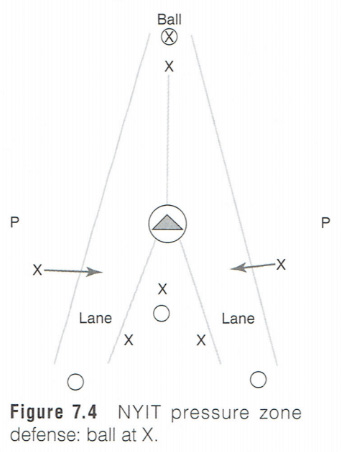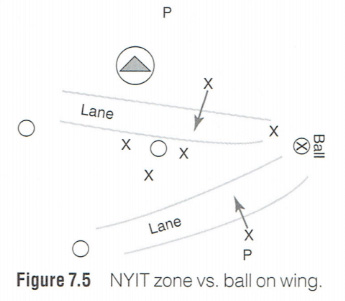|
By: Jack Kaley and Rich Donovan Originally Published in: Lacrosse Essentials Provided by: Human Kinetics Midfielders Two short-stick midfielders play at the top of the zone, and their job is to pressure the ball as it comes into the offensive zone. They must force the ball to the inside of the field. If their man carries the ball across the zone, then the adjacent short-stick defender doubles the ball at the seam (the seam vs. a two-man front is in the middle of the field). When the ball is doubled at the seam, the backer covers the vacated zone. If the top short-stick midfielder is dodged and his man is going directly for the cage, the backer steps up and covers him. (See figure 7.3.)
One of the advantages of the zone is that you can use your regular offensive midfielders in these top spots. This is an advantage for several reasons. First, if you are limited in numbers, you do not have to have defensive specialists. Your midfielders can play this spot if they are fatigued because you don't mind if they get dodged as long as they force their men to the inside. Your opponent cannot isolate your midfielders. If they try to invert the midfielder behind, he simply passes his man off to the next man in the zone. Having offensive midfielders at the defensive end is an advantage of the transition game. Backer The backer should be one of your more aggressive defenders. This should be someone who likes to double the ball and doesn't mind knocking people down if he needs to. A football linebacker type would be ideal for this position. He must also be a vocal leader because he is the quarterback of the defense. He is also the initiator of the transition game. Creaseman The creaseman plays the crease when the ball is on top, and he plays X when the ball is behind against an odd set. The crease defenseman should be your best takeaway player. Like the backer, he should be vocal and a good leader. The backer and crease positions are interchangeable. For example, when going against an odd set (for example, 1-3-2), the crease-man plays the man at X when the ball is behind and the backer plays the backer's spot. When the ball is out front, the backer backs up the ball and the creaseman plays the offensive creaseman. Against a 2-2-2 formation, the wingmen play the ball behind, and the crease defender and backer are on the crease. When the ball is behind, the onside player is the backer and the offside defender plays the onside crease. When the ball is exchanged to the other side below the GLE, the creaseman becomes the backer and the backer covers the onside crease. The offside creaseman, in both scenarios, is covered by the far-side defensive midfielder. Wing Defenseman Your wing defensemen must be players who understand the lanes. They do not have to be as quick as your creaseman or backers, but they should have a high lacrosse IQ because very often they cover the most dangerous offensive player on the crease. All defensive players must be vocal. Communication is the key to success whether you are playing man to man or zone. Begin to pressure as soon as the offense brings the ball into the offensive zone. Three areas of the zone are considered all-out pressure points. Two of them are in the top spot, occupied by your short-stick midfielders. The third is by the crease defenseman, who pressures the ball at X. The midfielders pressure the ball as soon as it comes into the restraining area and force the ball to the inside. If this man carries the ball across the top of the zone, he will be doubled at the seam by the other adjacent short-stick midfielder, and the backer will fill in all vacated zones because of doubles. Anytime the dodger goes right to the cage, the backer is responsible for picking him up. The other pressure point is the attackman at X. He is pressured relentlessly by the crease defensemen. Again, his responsibilities are the same as the short-stick midfielder's. He takes away from the outside, but if he is dodged, he gives the attackman the inside. The backer meets the dodger at the goal line extended, and the creaseman follows up for the back check (see figure 7.4).
The wing defensemen (long-stick midfielder and other defensemen) do not pressure the ball on the wings. The following are the responsibilities of the basic positions against a 1-3-2 set. The player covering the ball carrier must pressure the ball. The two adjacent men are responsible for the skip lane and for their man. The backer is always between the ball carrier and the crease area. The two men farthest away from the ball have responsibility for the offensive players and the creaseman. For example, if the ball is being played by the LSM on the wing, the far-side short-stick midfielder and Defensive wing slough in to cover the crease. Only one of them actually guards the creaseman. If the creaseman plays high, the far-side midfielder covers him. If the creaseman plays low, the off-wing defenseman covers him. The creaseman's position is at the GLE with his stick covering the skip lane to the far-wing attackman. It is important that the adjacent men on either side of the ball have their sticks up in the skip lanes. Their responsibilities are always in the order of man, ball, and lane (see figure 7.5).
|









